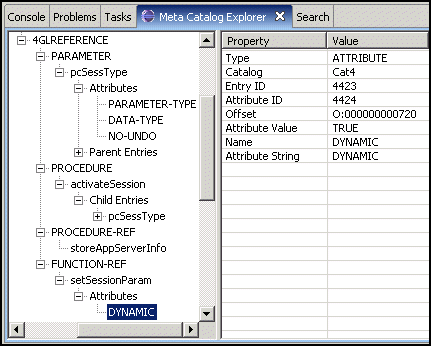|
Content type
|
Entry type
|
Entry
|
|
ABLREFERENCE
|
PROCEDURE
|
The procedure name.
|
|
FUNCTION
|
The function name.
|
|
|
METHOD
|
The method name.
|
|
|
PARAMETER
|
The parameter name.
|
|
|
PROCEDURE-REF
|
The name of the referenced procedure.
|
|
|
FUNCTION-REF
|
The name of the referenced function.
|
|
|
METHOD-REF
|
The name of the referenced method.
|
|
Entry type
|
Attribute
|
Value
|
|
PROCEDURE
|
ACCESS-MODIFIER
|
PRIVATE
|
|
PARAMETER
|
PARAMETER-TYPE
|
INPUT, OUTPUT, or INPUT/OUTPUT.
|
|
DATA-TYPE
|
The parameter's data type.
|
|
|
LIKE
|
TRUE if defined with the LIKE option.
|
|
|
EXTENT
|
The extents, if any.
|
|
|
NO-UNDO
|
TRUE if set.
|
|
|
FUNCTION
|
RETURN-DATA-TYPE
ACCESS-MODIFIER
|
The data type returned by the function.
PRIVATE
|
|
METHOD
|
RETURN-DATA-TYPE
ACCESS-MODIFIER
|
The data type returned by the function.
PUBLIC, PROTECTED, or PRIVATE
|
|
FUNCTION-REF
|
DYNAMIC
|
TRUE if call uses DYNAMIC-FUNCTION.
|
|
PROCEDURE-REF
|
PERSISTENT
|
TRUE if procedure is run persistently.
|
|
Content Type
|
Entry type
|
Entry
|
Attributes
|
Attribute values
|
|
ABLREFERENCE
|
PROCEDURE
|
activateSession
|
|
|
|
PARAMETER
|
pcSessType
|
PARAMETER-TYPE
|
INPUT
|
|
|
DATA-TYPE
|
CHARACTER
|
|||
|
NO-UNDO
|
TRUE
|
|||
|
PROCEDURE-REF
|
storeAppServerInfo
|
|
|
|
|
FUNCTION-REF
|
setSessionParam
|
DYNAMIC
|
TRUE
|
